|
1.
CENTRAL/ WEST AFRICA
Prices for African timber products retain recent gains
Prices for Central/West African timber products held onto recent gains achieved in early January. Good demand for
both logs and lumber kept the overall market very firm. Fears of weaknesses in some prices failed to materialize as
the mild winter in Europe held demand unusually firm while sales to Asia remained strong. The Chinese New
Year starting 18 February is also said to be a factor as the associated festivities is expected to affect the production
of timber and timber products in Southeast Asia.
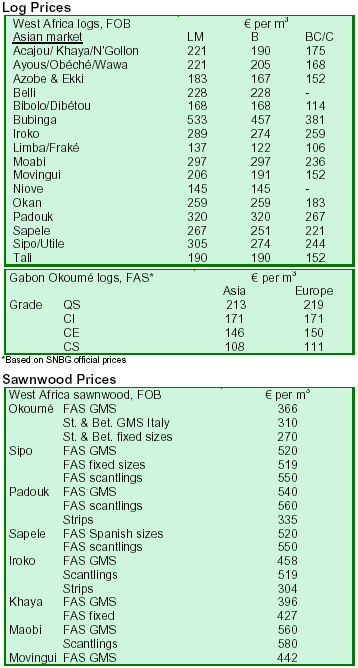
2. GHANA


3.
MALAYSIA
Prices surge moderately as flooding recedes
Prices of timber products increased moderately as the month-long flooding receded in most states with the
exception of Sarawak, where heavy rainfall continues to flood several key towns and major highways.
Uninsured mills could go out of business
Damages by the flooding are expected to exceed earlier estimates of 100 million ringgit. The Chief Minister of
Sabah announced that the state government estimated that it would cost 87 million ringgit to repair infrastructural
damage in this state alone. The assessment of damages to the timber industry was still underway. However, a
number of smaller sawmillers and manufacturers might go out of business as such natural disasters are often not
insurable in the country.
Flooding aftermath effect on prices could be mixed
Prices of raw material for plywood and panel products are expected to fall slightly as oil palm plantations begin the
removal of massive volume of damaged palm trees and debris from their estates across the country, especially in
the states of Johor and Pahang. Nevertheless, reconstruction of properties and infrastructure within the
country alone is set to push prices of timber products to a record high for most of the year. With the ongoing acute
shortage of raw material for the timber industry in Malaysia, value-added products in the downstream sector
such as furniture will also face serious challenges in keeping raw material cost in check.
Malaysia and EU agree on an independent body
Malaysia and the EU have agreed that an independent body will be assigned the task to ascertain whether
Malaysian timber products exported to EU countries are from legal sources. This
independent body, to be appointed via joint consensus between Malaysia and the
EU, will function as the auditing body to certify that Malaysian timber and related products exported to EU
countries are those that originated from legal timber sources.
This decision was reached following formal talks between the EU commissioners and Malaysian authorities in
Sarawak recently (see TTM 12:1). The EU delegation, led by the European Commission Director of International
Affairs, Directorate of Environment, Soledad Blanco, was
in Malaysia to negotiate a partnership agreement to allow Malaysian timber to gain entry into all the 25 EU
countries.
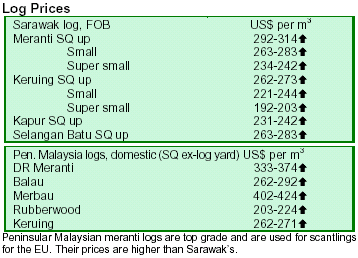
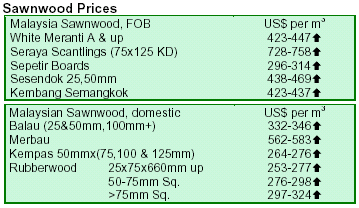
4.
INDONESIA
Impact of flooding on timber industry unclear
The flood situation in Indonesia has improved. However, Indonesian authorities have yet to disclose information
concerning flood related damage to its infrastructural system. Some Indonesian timber traders have reported
severe damage to upriver piers and jetties in Sumatra, where raw logs are floated down to sawmills and plywood
mills downstream. It is not clear whether an assessment of
the damage to the timber industry would be carried out.
Shortages in Australia could drive timber demand up
The Indonesian timber industry may be moving towards a boom caused by recent mega bushfires in Australia. The
fires have destroyed thousands of hectares of forests across Australia over the last month. Facing the worst
drought in the last 100 years, a poor harvest is also expected in the Australian forestry industry. An acute
shortage of raw timber material in Australia is therefore expected, according to some analysts.
Ban on sand exports may fuel Indonesian timber exports
A recent ban on sand exports by Indonesia may further fuel exports of Indonesian timber products to Singapore.
The ban is forcing Singaporean companies to search for alternative construction materials, including timber.
Construction contracts in Singapore grew 40% in 2006 and an upward momentum is expected in 2007.
The Indonesian plywood and panel products sector is expected to gain the most from demand from Australia and
Singapore. However, Indonesia's ability to meet this demand will be closely
scrutinized by the international timber trade community.
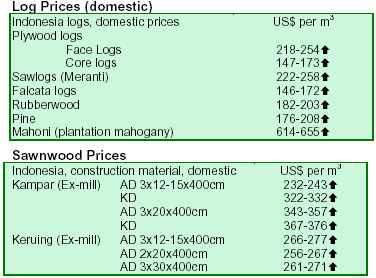
5.
MYANMAR
Teak
tender prices ahead of direct sales prices
Teak prices remained firm throughout 2006. Total teak log sales are roughly estimated at about 300,000 hoppus tons
in the year. Teak logs sold by tender and sealed tender sales are estimated at only about 33,000 hoppus tons while
direct sales accounted for the balance. Therefore, tender
prices represent only a partial view of the market. In fact, direct sales prices tend to be lower than those for tender
sales. For example, ruling direct sale prices at the beginning of 2007 for sawing grades 4 to 8 (SG-4 to SG-8)
were $1,539, $1,082, $854, $665 and $595, compared with December tender prices of $1,633, $1,427, $1,181, $913
and $831, respectively.
Pyinkadoe and gurjan markets show mixed trends
The end of 2006 continued to show a surplus of pyinkadoe logs at the depots with more logs expected to arrive in
January and February. The slow turnover is said to be due to high log prices. However, pyinkadoe, unlike gurjan
(keruing), is a durable timber species that could be stored
for long periods awaiting shipment. In contrast, the market for gurjan is good. The surplus of gurjan logs that was
evident in Yangon log depots early in 2006 was disposed off throughout the year. Fresh gurjan logs are at price
levels affordable to foreign buyers.
Upbeat outlook for 2007
The teak market is expected to remain firm and steady in 2007. The market for hardwood logs, especially gurjan, is
promising. Gurjan is sought after for the sawing, plywood and container flooring industries. Indian buyers increased
the demand for teak logs during the end of 2006. India is expected to continue to be a good market for SG-5, SG-6,
SG-7 and SG-8 teak logs. China would continue to be an important market while Vietnam is expected to increase its
presence in the Myanmar teak market. This country has become a successful exporter of teak finished products.
Demand from Vietnam, however, may slow down slightly in early 2007 due to overstocks, but would likely remain a
good market, according to analysts.
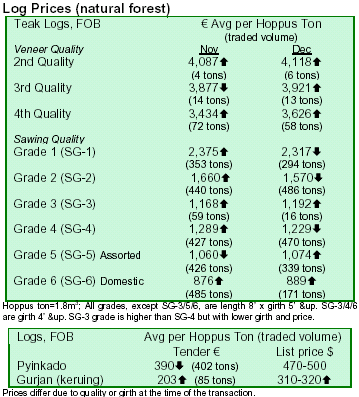
6. PAPUA
NEW GUINEA
PNG log exports soar in November
Log exports from PNG rose to 300,549 m3 in November 2006, up 11% from October and 41% from November
2005. Accumulated log exports in the year to September were 16% ahead of the pace last year (see chart).
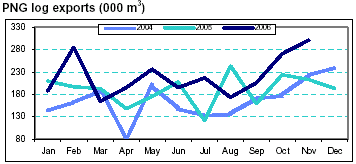
Total log exports (excluding plantation) amounted to 2.62
million m3 in the period from December 2005 to November 2006. Saw/veneer grades accounted for 87.4%
of the total. Main log export species were taun, malas, bintangor and terminalia. China took 83.4% of all log
exports, followed by Japan (7.4%), Korea (3.2%) and Vietnam (2.9%). Of the saw/veneer log grades, China
imported 89.4%, Japan 5.1%, Korea 2.4% and India 1.5%. For plantation species, kamarere remained the main export
species primarily to the markets of Vietnam, Japan, China and Korea.

7. BRAZIL
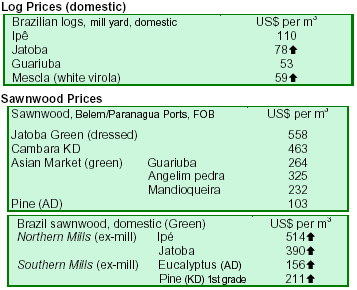
8. PERU
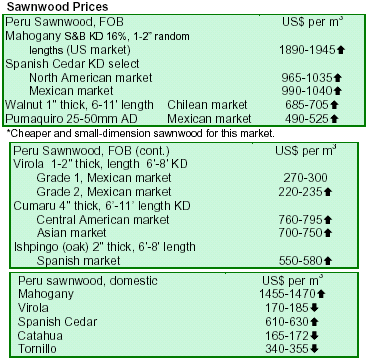
9. BOLIVIA

10. Guatemala

11.
Guyana
Exports of forest products continue to surge in 2006
Export earnings from the forestry sector in Guyana rose just over 22% to $59.5 million in 2006. As in previous
years, sawnwood, logs and plywood were the main products exported. To ensure that the forestry sector
continues to grow and value added activities are increased, a ministerial committee (including the Forest Products
Association and the Guyana Manufacturing and Services
Association) has been established to advise on Guyana¡¯s log exporting policy. This committee will also involve national consultations.
SGS suspends Barama's FSC certification
SGS-Qualifor has suspended Barama Company Ltd., FSC certification due to failures to
implement some corrective actions. The certificate was awarded in February 2006 for 570,000 ha of its forests in west-central
Guyana by SGS and it was, until recently, the largest in the tropical region (see TTM 11:6). SGS issued corrective
action requests (CARs) detailing the mandatory
improvements in worker housing, hygiene and safety, and road planning, among others. WWF provided technical
support to Barama during the original FSC certification audit. SGS suspended the certification during its
November 2006 monitoring audit. Barama would need to address all the deficiencies specified by SGS to comply
with FSC standards.
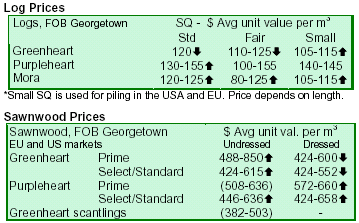
|